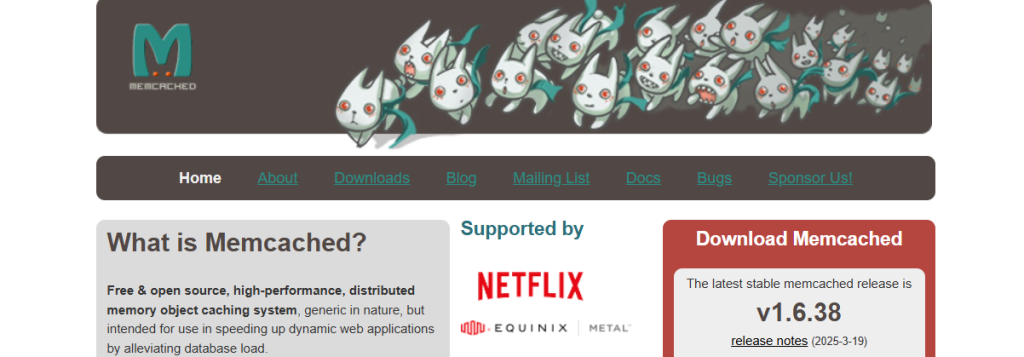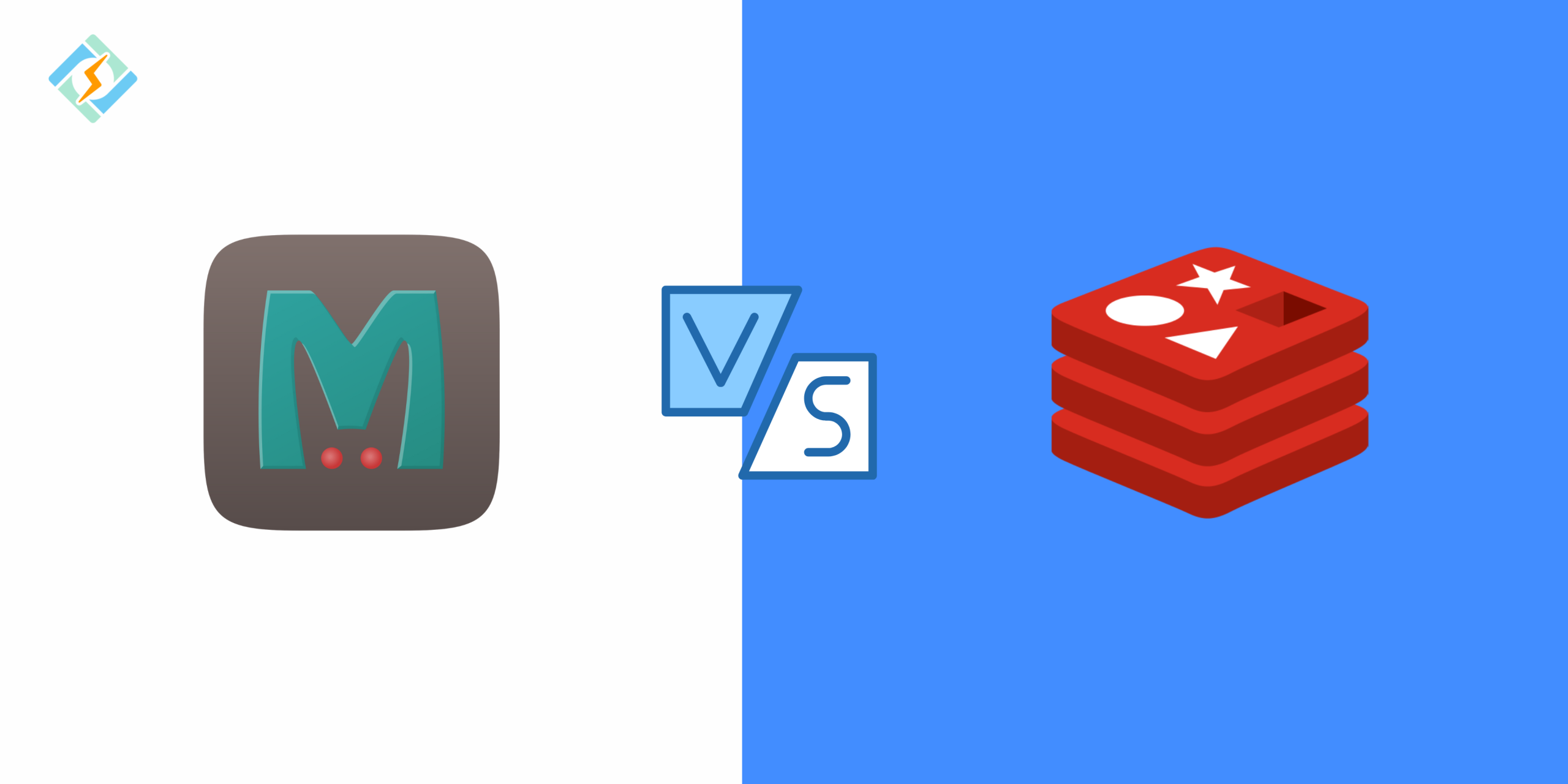The applications of today demand a great deal of speed. How you manage data retrieval frequently affects the performance of your backend services, from handling real-time chat applications and high-frequency APIs to supplying content in milliseconds. Although they are not designed for real-time performance, traditional databases like MySQL and PostgreSQL are great for permanent storage. In-memory data stores are useful in this situation.
While comparing Memcached vs Redis, these two are the most popular tools for this task. Both are in-memory key-value stores that are open-source and offer lightning-fast data access. Although their goals are similar, their features, capacities, and ideal use cases differ significantly.
In this comprehensive post, we’ll examine the comparison of Memcached vs Redis, evaluate them along important dimensions, and assist you in selecting the best option for your application.
Introduction of In-Memory Caching
It’s critical to comprehend the significance of in-memory caching before delving into the comparison of Memcached vs Redis.
Caching is a technique for temporarily keeping data in memory to speed up response times to subsequent requests for that data. You save the same result in RAM for a brief amount of time rather than continuously retrieving it from a database.
Advantages of caching
- Speed: Compared to disk-based storage, RAM is far faster.
- Decreased Load: Decreases the quantity of queries sent to your database.
- Scalability: Lowers latency under heavy load, allowing applications to grow.
What is Memcached?

Memcached is a distributed memory object caching system with excellent performance. Brad Fitzpatrick created it initially for LiveJournal in 2003, and it has since grown to be the standard for basic key-value caching in other large-scale applications.
Get exclusive access to all things tech-savvy, and be the first to receive
the latest updates directly in your inbox.
Important Features of Memcached:
- Only in memory: It doesn’t encourage perseverance.
- String keys and values are used to store arbitrary data in a key-value store.
- Complex data types, such as lists and sets, are not supported by the simple data model.
- Multi-threaded: Capable of effectively utilising several CPU cores.
- eviction for Least Recently Used (LRU).
Typical Use Cases
- Storage of sessions (if persistence is not needed)
- Temporary caching of objects
- Optimisation of content delivery
What is Redis?

There is more to Redis (REmote DIctionary Server) than just a cache. Salvatore Sanfilippo originally made this open-source, multipurpose in-memory data structure storage available in 2009.
Key Characteristics of Redis
Rich data structures, including strings, hashes, lists, sets, sorted sets, streams, and more, are among Redis’s primary features.
- Options for persistence: Append-only files (AOF), snapshots (RDB), and hybrid techniques are supported.
- I/O multiplexing through event loops is supported by the single-threaded core.
- High availability is achieved by built-in replication and clustering techniques.
- Lua and Pub/Sub scripting.
Common Use Cases
- Analytics in real time
- Rankings and leaderboards
- Job brokers and task queues
- Chat programs and pub/sub networks
Architecture Comparison
Memcached vs Redis have quite different designs.
Memcached’s basic design consists of a memory-efficient key-value cache that is slab-allocated. It focusses on storing little, ephemeral amounts of data with low complexity and great performance, and it employs a multithreaded approach to utilise many CPU cores.
In contrast, Redis is a single-threaded event loop server that provides a lot more than just caching. It is made to function as an in-memory database in addition to a cache, enabling sophisticated data types and persistence mechanisms. Flexibility and usefulness are given priority, however there may be a modest increase in memory and CPU overhead.
Redis is a more reliable option for mission-critical systems because it also comes with built-in support for high availability.
Use cases and Data Structures
The types of data that Memcached vs Redis support are among their most significant distinctions.
A pure key-value store is Memcached. Only strings can be stored as both keys and values. It doesn’t examine, index, or work with the contents of the stored value because it views values as opaque blobs. This limits Memcached’s versatility while maintaining its speed and efficiency.
Numerous data structures are supported by Redis:
- Strings: Memcached-like basic key-value pairs
- Useful for expressing items (like user profiles), hashes
- Lists are collections of strings arranged either FIFO or LIFO.
- Sets are haphazard groups of distinct components.
- Sorted Sets: Scored sets that are ideal for leaderboards
Bitmaps, streams, and hyperloglogs are used for analytics, unique item counts, and real-time event processing.

Redis is perfect for more complex use cases because of these data structures, including:
- Using lists to create stacks or queues
- Sorting sets to create leaderboards
- Handling chat messages or user sessions in real time
- Rate-limiting APIs with expiration and counters
Redis is a better option if your use case calls for more than simple key-value retrieval.
Persistence
Specifically, Memcached was intended to be a volatile cache. All data is lost when you restart or shut it down. Because of this, it is appropriate for temporarily storing data that can be restored or retrieved from a primary source.
Redis provides a number of persistence techniques:
- RDB (Snapshotting): Preserves data snapshots at predetermined times.
- Append-Only Files (AOFs): Record each write action to the disc.
- A hybrid technique balances durability and performance by combining the two approaches.
Because of these characteristics, Redis can serve as a primary in-memory database for some applications in addition to being a cache. Memcached does not allow you to safely restart Redis or recover data after a crash
Replication and Clustering
Clustering and replication are not natively supported by Memcached. You must either manually shard data or use a proxy like Twemproxy or Facebook’s mcrouter if you wish to scale Memcached horizontally. This increases intricacy and could impact node-to-node consistency.
Redis offers excellent distributed system support. It provides:
- For read scalability and redundancy, use master-slave replication.
- For notifications, automated failover, and monitoring, use Redis Sentinel.
- Redis Cluster: For fault tolerance, data partitioning, and horizontal scaling
In high-availability production settings, Redis is far more scalable and dependable because to its inbuilt clustering.
Memory Management
For effective memory use, Memcached divides memory into chunks using a slab allocation technique. When space runs out, it uses an LRU (Least Recently Used) eviction policy to get rid of outdated or unnecessary material.
Redis gives you much greater control over how much memory you use. A variety of eviction policies are available to you:
- Noeviction: When memory is full, new writes are not allowed.
- Remove the least recently used keys with allkeys-lru.
- volatile-lru: Get rid of LRU keys that have an expiration date set
- Evict random keys at random
- Evict keys with the shortest lifespan using
volatile-ttl
To lessen its footprint, Redis also employs memory-efficient encodings for data structures like lists and hashes. Developers have far more control over how Redis responds to memory demand thanks to these features.
Performance and Latency
While comparing Memcached vs Redis, both are very quick. They can manage millions of requests per second with little delay and are tuned for in-memory access.
Due to its multithreaded architecture and lack of features, Memcached usually performs marginally faster than Redis in terms of raw speed for simple operations like GET and SET.
Redis uses event-based I/O to effectively manage numerous concurrent connections even if it is just single-threaded for command execution. Additionally, it enables pipelining, which batches several tasks to increase performance.
Under typical load circumstances, both systems have sub-millisecond latency performance. Nonetheless, Redis’s vast feature set and improved memory management can result in enhanced speed in practical applications that surpass basic key-value access.
Control of Access and Security
Authentication and encryption are not natively supported by Memcached. It was intended for usage in secure, remote settings. To protect it, you have to rely on network-layer controls like firewalls or VPC rules.
Redis offers additional choices:
- Using the AUTH command to demand a password
- Access Control Lists (ACLs) to limit user commands
- Encrypting data with TLS/SSL for safe transmission
- Capacity to use UNIX sockets or bind to particular IPs
Redis is better suited for deployment in semi-trusted or public situations and is by default far more secure.
Ecosystem and Tooling
The ecosystem of Memcached is limited and basic. It comes with libraries for the majority of programming languages and a simple CLI interface. It does not, however, have sophisticated analytics, visualisation, or monitoring tools.
Redis has a thriving ecosystem.
- RedisInsight: An effective graphical user interface for tracking and troubleshooting
- Expand functionality with Redis Modules (e.g., RedisJSON, RedisSearch, RedisGraph)
- Rich command set for working with data is provided via CLIs and APIs.
- Monitoring: Facilitates connection with Datadog, Prometheus, New Relic, and other tools.
- Redis Enterprise, AWS ElastiCache, Azure Redis, and GCP MemoryStore are examples of hosted options.
Because Redis’ ecosystem is far more developed and expandable, it is simpler to incorporate into contemporary cloud-native and DevOps processes.
Support and Community
Memcached vs Redis are both widely used and open-source.
Redis boasts a wider range of contributors and a bigger, more engaged community. Additionally, it has commercial support through Redis Inc., which provides advanced modules, hosted services, and enterprise-grade support.
Although development activity has decreased in comparison to Redis, Memcached is still widely used, particularly in legacy applications. Its simplicity is a virtue and a drawback.
Which One Should You Choose?
Memcached is a great option if your use case is restricted to quick, non-persistent key-value caching and you’re working in a reliable internal network. It is incredibly quick, memory-efficient, and easy to set up.
However, Redis is the best option if you require more sophisticated data processing, persistence, security, and scalability. It is made to manage real-time data processing, analytics, and message queuing in addition to caching.
For complicated applications, Redis offers you greater flexibility, control, and future-proofing.
Memcached vs Redis: Quick Comparison
| Feature | Memcached | Redis |
|---|---|---|
| Data Types | Strings only | Strings, Lists, Sets, Hashes, etc. |
| Persistence | No | Yes (RDB, AOF) |
| Use Cases | Simple caching | Caching, queues, real-time apps |
| Clustering | No native support | Yes (Redis Cluster) |
| Replication | No | Yes (master-slave, Sentinel) |
| Multithreading | Yes | No (single-threaded, event-based) |
| Security | Basic (network-level only) | AUTH, ACLs, TLS |
| Performance | Faster for simple get/set | Slightly slower, but more versatile |
| Memory Control | LRU eviction only | Multiple eviction policies |
| Tooling | Basic CLI | Rich tools (RedisInsight, modules, GUIs) |
Real-World Use Cases
Memcached in the wild:
- Memcached was first utilised by Facebook to cache user information and lessen database load.
- Wikipedia uses Memcached to cache the content of its articles.
- It has been used by Twitter and YouTube to store metadata and distribute content.
Wild Redis:
- Redis is used by GitHub to manage caching, queueing, and background tasks.
- Redis is used by Snapchat for real-time communications and analytics.
- Redis is used by Twitter to control notifications and timelines.
- Redis is used by Stack Overflow for caching, user sessions, and tag analytics.
Redis’ extensive feature set and extensibility allow it to maintain its dominance in contemporary tech stacks.
In conclusion
Memcached vs Redis are both crucial components of the backend architecture of scalable, quick apps. Memcached is ideal for straightforward, fast caching since it is lean and mean. A powerful data store that fills the void between conventional caches and complete databases is Redis.
There isn’t a single, universal solution. The requirements, architecture, and complexity tolerance of your project will determine which tool is best.
Redis is difficult to top, though, if you’re searching for a versatile, future-proof solution that can manage more than just caching.
FAQs
What is the primary distinction between Redis and Memcached?
Memcached is a straightforward, fast, in-memory key-value store made specifically for text caching.
Redis is a more sophisticated in-memory data store with scripting, replication, durability, and support for several data types (such as lists, sets, and hashes).
In the comparison of Memcached vs Redis which one is faster?
Because of its multithreaded architecture and constrained feature set, Memcached may be marginally faster for simple GET/SET operations involving simple string data. Redis, however, provides much greater flexibility and performance that is almost identical.
Are more intricate data structures supported by Redis than by Memcached?
Indeed. Lists, sets, sorted sets, hashes, bitmaps, streams, and more are among the many sophisticated data types that Redis supports. Memcached only accepts values that are plain strings.
Is Memcached less secure than Redis?
Indeed. TLS encryption, access control (ACLs), and authentication are all integrated into Redis. Because Memcached lacks built-in security mechanisms, network-level isolation and firewalls are required.



